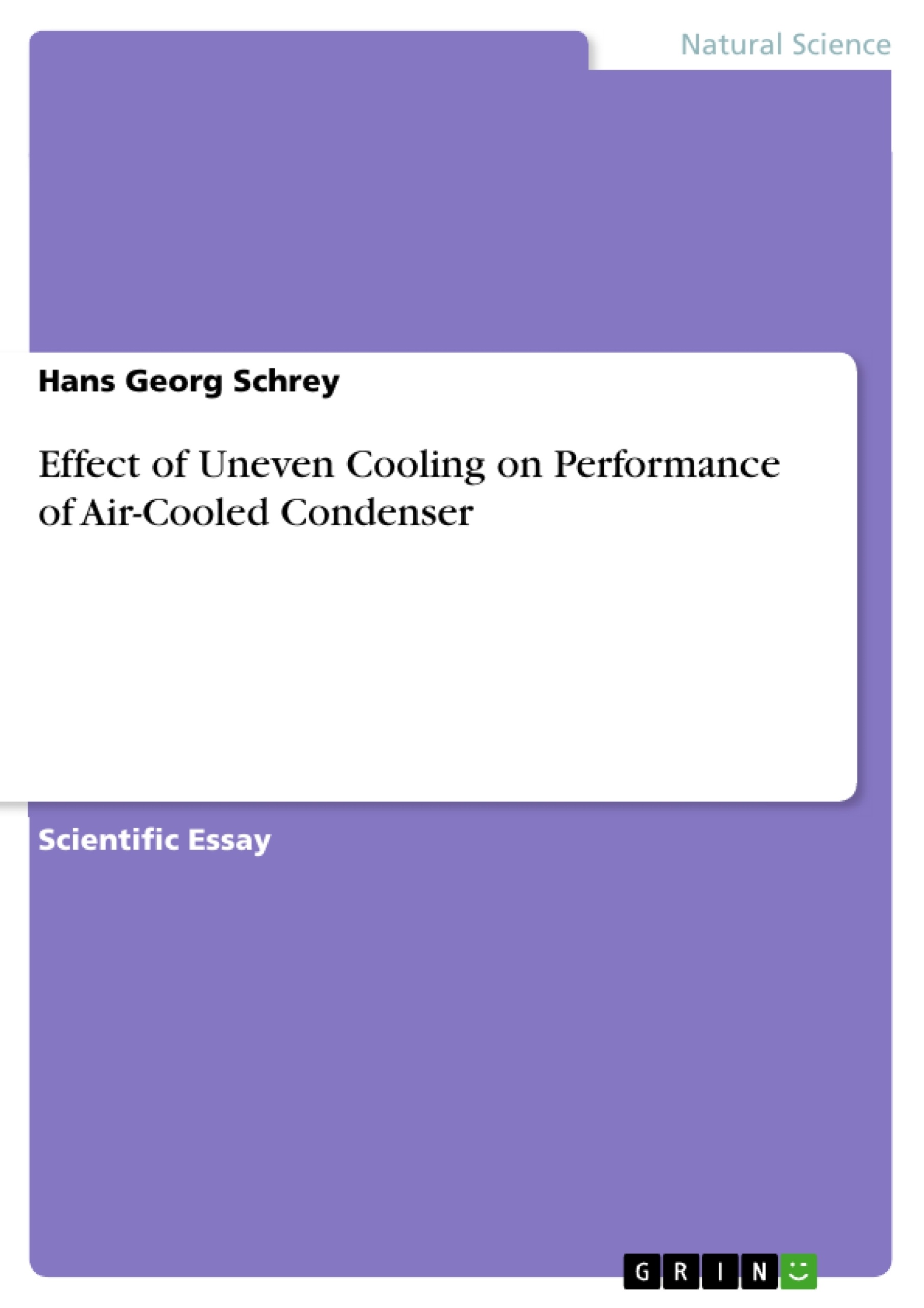Air-cooled condensers (“ACC”) operating in vacuum are widely used at the cold end of contemporary thermal power plants. Proper functioning of the condenser is paramount for power plant efficiency.
To adapt to changing process conditions because of changed ambient air temperature or power station load ACC streets are either taken out of or into service or, module fan speed settings are selected appropriately. Even if all fans are running at same speed local variations of cooling air flow may arise as a consequence of e.g. fan location or local wind impact. The designer must ensure that no negative effect (i.e. no cold spot) may evolve at the steam side of the ACC caused by uneven air side cooling or fan control.
The following note describes a theoretical method to assess the effect of air flow variations on ACC performance and provides simple rules to avoid potentially risky situations. An important role for safe operation plays the size of the secondary condenser. The procedure may be used as a guideline for proper sizing of the secondary condenser with respect to airflow maldistribution.
Inhaltsverzeichnis (Table of Contents)
- Abstract
- Introduction
- ACC Model
- Boundary Conditions
- Saturation Line
- Heat Balance of Primary Section
- Steam Side Pressure Drop
- Solution Regions
- Steam Flow
- Cold Spot
- Steam Side
- General Airside Velocity Profile
- Fan Speed Control Primary Condenser
- Fan Speed Effect on Steam Pressure
- Cold Spot Counteraction
- Conclusion
Zielsetzung und Themenschwerpunkte (Objectives and Key Themes)
The objective of this work is to present a theoretical method for assessing the impact of uneven airflow on the performance of air-cooled condensers (ACCs), focusing specifically on the risk of "cold spot" development. The methodology provides guidelines for proper sizing of secondary condensers to mitigate these risks.
- Effect of uneven cooling airflow on ACC performance
- Risk of cold spot formation and its consequences
- Role of dephlegmator sizing in counteracting cold spots
- Simplified ACC modeling for analyzing airflow maldistribution
- Development of practical guidelines for safe ACC operation
Zusammenfassung der Kapitel (Chapter Summaries)
Introduction: This chapter introduces air-cooled condensers (ACCs) used in thermal power plants and explains their two-stage condensation process involving primary and secondary condensers. It highlights the importance of maintaining even airflow to avoid cold spot formation due to uneven cooling. The chapter also mentions the use of fan speed control for load adaptation and the potential for wind effects on airflow distribution.
ACC Model: This chapter details a simplified model of the ACC, focusing on the primary condenser section. It simplifies the complex geometry of the ACC to a linear arrangement of modules to better analyze airflow variations. The chapter explains that varying cooling airflow leads to different condensation rates, and the importance of ensuring that condensation doesn't reach the tube ends to avoid cold spots.
Boundary Conditions: This chapter outlines the assumptions made for the ACC calculation model. It establishes a constant total airflow rate to isolate the effect of maldistribution, assuming a consistent ambient air temperature. The focus is on how the uneven distribution of this constant airflow impacts the system, not changes in the total air volume itself. This sets the stage for analyzing the maldistribution's effect on condensation.
Steam Side Pressure Drop, Steam Flow, Cold Spot, Steam Side, General Airside Velocity Profile, Fan Speed Control Primary Condenser, Fan Speed Effect on Steam Pressure, Cold Spot Counteraction: These chapters delve into the detailed analysis of the effects of uneven airflow on various aspects of the ACC's performance. They explore the relationship between airflow, steam pressure, condensation rates, and the development of cold spots. The analysis likely involves mathematical models and simulations, with the results used to develop strategies for mitigating cold spot formation. The details of these chapters are too complex to summarize at this level without risking a loss of accuracy. The essential takeaway is a deep investigation of the relationships between the various parameters of the ACC, and how uneven airflow directly affects the system's functionality.
Schlüsselwörter (Keywords)
Air-cooled condenser, ACC, cold spot, ACC control, dephlegmator sizing, uneven cooling, airflow maldistribution, condensation, steam pressure, fan speed control, thermal power plant.
Air-Cooled Condenser (ACC) Performance and Cold Spot Prevention: FAQ
What is the main objective of this document?
This document presents a theoretical method for assessing the impact of uneven airflow on the performance of air-cooled condensers (ACCs), particularly focusing on the risk of "cold spot" development. It aims to provide guidelines for proper secondary condenser sizing to mitigate these risks.
What is an ACC and why is even airflow important?
An ACC (Air-Cooled Condenser) is used in thermal power plants for condensation. Even airflow is crucial because uneven cooling can lead to the formation of "cold spots," which negatively impact performance and potentially cause damage.
What are the key themes explored in this document?
The key themes include the effect of uneven cooling airflow on ACC performance, the risk and consequences of cold spot formation, the role of dephlegmator sizing in counteracting cold spots, simplified ACC modeling for analyzing airflow maldistribution, and developing practical guidelines for safe ACC operation.
How does the document model the ACC?
The document uses a simplified model of the ACC, focusing on the primary condenser section. It simplifies the complex geometry to a linear arrangement of modules to better analyze airflow variations and the resulting condensation rates.
What are the boundary conditions considered in the model?
The model assumes a constant total airflow rate to isolate the effect of maldistribution, and a consistent ambient air temperature. The focus is on how the uneven distribution of this constant airflow impacts the system.
What aspects of ACC performance are analyzed in detail?
The detailed analysis explores the relationship between airflow, steam pressure, condensation rates, and the development of cold spots. This involves mathematical models and simulations to develop strategies for mitigating cold spot formation.
How does fan speed control relate to cold spot prevention?
Fan speed control is a method of load adaptation, and its effects on steam pressure and the likelihood of cold spot formation are investigated. The analysis explores how manipulating fan speed can be used to counteract the development of cold spots.
What are the key takeaways from the chapters on Steam Side Pressure Drop, Steam Flow, Cold Spot, Steam Side, General Airside Velocity Profile, Fan Speed Control Primary Condenser, Fan Speed Effect on Steam Pressure, and Cold Spot Counteraction?
These chapters provide a deep investigation into the relationships between various ACC parameters and how uneven airflow affects functionality. Due to the complexity, detailed summaries are omitted here, but the core message is a comprehensive analysis of the impact of uneven airflow.
What are the keywords associated with this document?
Air-cooled condenser, ACC, cold spot, ACC control, dephlegmator sizing, uneven cooling, airflow maldistribution, condensation, steam pressure, fan speed control, thermal power plant.
What is the structure of the original document?
The original document includes a table of contents, objectives and key themes, chapter summaries, and keywords. It provides a comprehensive overview of the research on ACC performance and cold spot prevention.
- Quote paper
- Dipl.-Ing. Hans Georg Schrey (Author), 2017, Effect of Uneven Cooling on Performance of Air-Cooled Condenser, Munich, GRIN Verlag, https://www.hausarbeiten.de/document/418540



